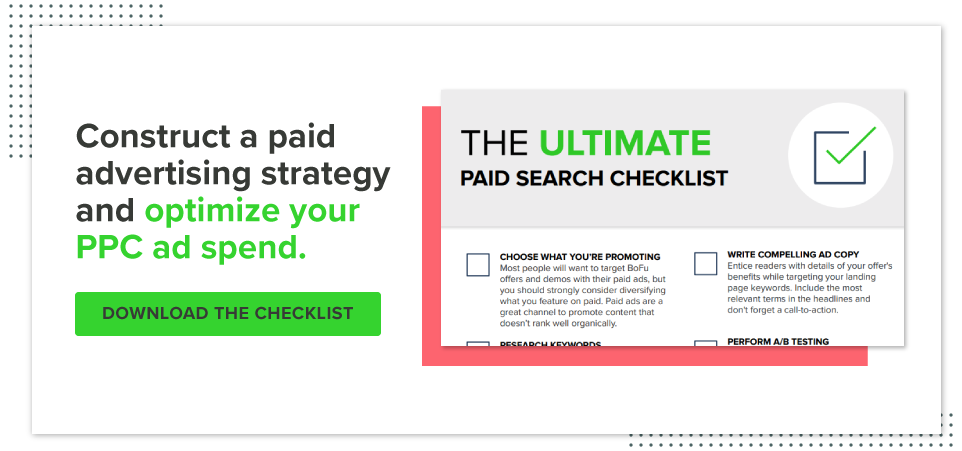How to Use Buyer Personas to Inform Your Ad Targeting

Paid advertising is an excellent way to put your content in front of your audience and drive a quicker time to value than your organic efforts.
Like any of your marketing efforts, you should have a keen understanding of your buyers to best address their needs and target them effectively with your paid efforts. That’s why it’s important for your organization to adopt buyer personas or semi-fictional representations of your ideal customers.
While your personas should absolutely inform the content you’re promoting and the design of your ads, you can also use your buyer personas to tailor your advertising audiences.
I sat down with New Breed Search Strategist Mike Shirk to discuss how you can start aligning your ad audiences with your buyer personas
Paid Social
Since your buyer personas should include demographic, firmographic and behavioral information about your customers, they are uniquely suited for paid social media audiences.
Demographic and firmographics
“When you have that demographic and firmographic information, you can almost one-to-one line up those demographics with attributes on LinkedIn,” says Mike.
On LinkedIn and to a lesser extent, Facebook, you’re able to target by specific job titles and functions that would likely already be included in your buyer personas. For example, if you have a buyer persona for a marketing leader, you could target anyone on the platform with a job title of vice president or director of marketing.
“You take your three or four buyer personas and just list out all of the potential job titles,” says Mike. “It’s such a good starting point for your campaigns and a very important place to begin when planning your initial strategy.”
Behavioral information
When defining your buyer personas, you may also include behavioral factors such as their browsing habits, resources they leverage or their day-to-day responsibilities.
Based on this information, you can start considering what groups or communities they may join on social platforms like LinkedIn and Facebook and align your targeting accordingly.
“Since job titles and functions can vary from business to business, you can occasionally miss out on ideal buyers,” says Mike. “Targeting by group membership is a great way to cast a wider net and reach more of your desired audience.”
Membership in a group provides further insight into someone’s interests or operational role, regardless of what their job title or function says they do. Taking the example of your marketing leader persona again, you may consider targeting by membership in LinkedIn groups like B2B Technology Marketing or Digital Marketing.
Expanding your audience
Depending on your personas, you may run into situations where your audiences feel as though they are too targeted, and that’s okay.
“Any way you can start to better define your audience, the better,” says Mike. “You may not reach as wide a population, but you’ll generate better results by targeting the right people.”
After running campaigns with your persona audiences, you can start expanding your targeting by using lookalike audiences. With lookalike audiences, your advertising platform of choice will take the audience you have already defined and expand it based on people they believe are likely to interact with your ads or possess similar but not currently defined characteristics.
Paid Search and Display
When it comes to paid search, targeting by your personas is less about building audiences and more about using your personas to inform your keywords.
Keywords
“If your [search] campaign is intended for a particular persona, then you need to ensure that the keywords you’re targeting are aligned with what their mentality is,” says Mike.
To do this, you should consider the challenges and pain points that you’ve detailed for your personas. What sort of questions are they typing into a search bar? What results are they hoping to find during their search?
By considering the search intent of your personas, you’ll be better able to research and bid on keywords that align with each persona’s individual needs and target them effectively.
Take for example, if your buyer personas were designed to be roles within a similar organization: Your keyword strategy for someone who fills the champion persona may be more education-forward or guiding them toward content that helps them do their job better. For a decision-maker persona, your keywords may be targeted more toward the immediate challenges that they face and guiding them toward your solution.
Custom intent audiences
Where you can create more targeted audiences in paid search are through Google’s custom intent audiences. While many inbound paid campaigns focus on nurturing prospects until they’re ready to purchase from you, custom intent audiences are designed to reach prospects currently in the market for a product or service you offer.
These audiences power ads on the Google Display Network and YouTube video ads and are made up of factors including keywords, web pages visited, videos watched and purchasing behavior.
“Basically you’re building a targeting system based on what people have been searching lately or what they’re interested in,” says Mike.
Again, these audiences can be directly informed by the behavioral information and challenges that you have outlined in your buyer personas.
An additional function of a custom intent audience is to include competitor sites in your targeting. If you’ve designed buyer personas around pain points and challenges, you know the solutions they will be searching for and can include competitors who offer similar solutions in an effort to have your brand be top of mind.
Measuring Success
How can you be sure that your audiences are aligned with your buyer personas? Generally, it boils down to the quality of your leads.
If the contacts you’re creating from your paid advertising efforts are consistently being marked unqualified, it’s a good sign that your ads aren’t reaching the right audience, but there are other metrics to consider as well.
“Another thing to look at is your click-through rate. Are people who see your ads actually clicking on them?” says Mike. “If you aren’t meeting the benchmark for your industry, something may be wrong.”
That said, the problem isn’t necessarily your audience. When your ads aren’t performing well, it’s important to consider whether you’re promoting the right offers and the design of your ads. At the end of the day, everything about your campaigns — not just your audience — should be directly informed by your buyer personas.
Chris Singlemann
Chris is a Brand Marketer at New Breed where he is responsible for crafting design and video assets that support our brand. When he's not behind the camera, he enjoys kayaking and tending to his sourdough starter.





